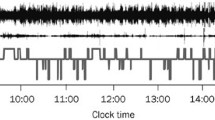High anxiety is a personality features which is largely genetically determined and is due to the functioning of the limbic system and the activity of cerebral formations involved in maintaining waking and the development of sleep. Analysis of experiments on animals and clinical observations indicates that this feature, determining an individual’s own responses, promotes the development of anxiety and anxiety disorders which, due to suppression of GABA-benzodiazepine inhibitory influences, has adverse effects on the duration and quality of nocturnal sleep. Phenazepam, acting via its anxiolytic properties, inactivates foci of arousal in the nervous system, countering the negative manifestations of anxiety, resulting in a somnogenic action which normalizes sleep impairments.
Similar content being viewed by others
References
A. Golbin, H. Kraviyz, and L. Keith, Sleep Psychiatry, Taylor & Francis, London, New York (2004).
E. V. Verbitskii, Sleep and Anxiety, Southern Scientific Center, Russian Academy of Sciences, Rostov-on-Don (2008).
Yu. A. Aleksandrovskii, Borderline Mental Disorders, Meditsina, Moscow (1993).
M. W. Eysenck, “Anxiety and attention,” Anx. Res., 1, 9–15 (1988).
P. V. Simonov, Lectures on the Operation of the Brain. A Needs-Information Theory of Higher Mental Activity, Institute of Psychology, Russian Academy of Sciences, Moscow (1998).
R. V. Buzunov, Sleeplessness in Clinical Practice. Textbook, www.sleepnet.ru/vracham/library/bessonnitsa-v-praktike-terapevta/.
A. V. Kaluev, Stress, Anxiety, and Behavior: Current Problems in the Modeling of Anxiety Behavior in Animals, Kiev State University Press, Kiev (1998).
A. V. Kaluev, Grooming and Stress, AVIKS Press, Moscow (2002).
M. A. Deryagina and M. L. Butovskaya, Primate Ethology, Moscow Sate University Press, Moscow (1992).
Yu. L. Khanin, A Brief Handbook on the Use of Reactive and Endogenous Anxiety Scales, LNIITEK Press, Moscow (1976).
C. D. Spielberger, R. L. Gorsuch, and R. E. Lushene, STAI Manual for the State-Trait Anxiety Inventory, Consulting Psychology Press Palo Alto, New York (1970).
H. Heckhausen, Motivation and Activity [Russian translation], Mir, Moscow (1986).
E. V. Verbitskii, The Psychopharmacology of Anxiety, Rostov State University Press, Rostov-on-Don (2003).
A. Kalueff and J. LaPorte, Experimental Animal Models in Neurobehavioral Research, NOVA Science, New York (2009).
E. L. Hartmann, The Functions of Sleep, Yale University Press, New Haven and London (1973).
V. M. Koval’zon, Basic Somnology, BINOM Press, Moscow (2011).
V. M. Koval’zon and V. V. Dolgikh, “Regulation of the sleep-waking cycle,” Nevrol. Zh., 6, 316–322 (2016), https://doi.org/10.18821/1560-9545-2016-21-6-.
V. M. Kovalzon, “Ascending reticular activating system of the brain,” Transl. Neurosci. Clin., 2, No. 4, 275–285 (2016), https://doi.org/10.18679/CN11-6030/R.2016.034.
P. S. Kupalov, Mechanisms of Closing Temporal Links in Health and Pathology, Meditsina, Moscow (1978).
A. Borbely, O. Hayaishi, T. Sejnowski, and J. Altman, The Regulation of Sleep, Human Frontier Science Program: Strasbourg (2000).
A. M. Petrov and A. R. Giniatullin, The Neurobiology of Sleep: a Current View: Textbook, Kazan State Medical University, Kazan (2012).
Benzodiazepines: Good Practice Guidelines for Clinicians, All Ireland Public Health Repository, Department of Health (Ireland) (2002), last upd. 12.21.2016, https://doi.org/10.14655/771574-773355.
S. L. Kuznetsov and M. A. Afanas’ev, “Importance of the early response gene c-fos and its expression products in neurons in various conditions,” Biomeditsina, 1, No. 1, 109–116 (2013).
Ya. I. Levin and M. G. Poluektov, Somnology and Sleep Medicine. Selected Lectures, Medforum, Moscow (2013).
M. G. Poluektov, Somnology and Sleep Medicine: National Guidelines in Memory of A. M. Vein and Ya. I. Levin, Medforum, Moscow (2016).
M. H. Kryger, T. Roth, and W. C. Dement, Principles and Practice of Sleep Medicine, Elsevier, Philadelphia (2016).
Yu. Yu. Sysoeva and E. V. Verbitskii, “Individual cyclical changes in δ activity in the brain during slow-wave sleep in humans,” Dok. Akad. Nauk, 444, No. 1, 1–5 (2012).
Yu. Sysoeva and E. Verbitsky, “The combination of high trait anxiety and female sex is vulnerability factor for sleep disturbances,” in: Trait and State Anxiety: Assessment, Predictor and Outcomes, Nova Publishers, New York (2016), Library of Congress Control No. 2016933393, ISBN: 978-1-63484-860-2 (eBook), https://www.novapublishers.com/catalog/product_info.php?products_id=57755&osCsid=b3c3d95bcc67795f9e57f2e60186feb4.
Yu. Yu. Sysoeva and E. V. Verbitskii, “The nature of activation of the brain during nocturnal sleep is associated with individual endogenous anxiety,” Dokl. Akad. Nauk., 461, No. 2, 1–3 (2015).
Yu. Yu. Arapova, A. I. Shikhliarova, E. V. Verbitsky, E. E. Rostorguev, N. S. Kuznetsova, and T. P. Protasova, “Electroencephalographic activity of wakefulness and sleep associated with primary brain tumors in human: a pilot study,” J. Sleep Med. Disord., 3, No. 7, 1068–1075 (2016).
E. V. Verbitskii, “Anxiety and sleep,” Zh. Vyssh. Nerv. Deyat., 63, No. 1, 6–12 (2013).
V. M. Koval’zon, Sleep Neurophysiology and Neurochemistry: National Guidelines in Memory of A. M. Vein and Ya. I. Levin, M. G. Poluektov (ed.), Medforum, Moscow (2016), pp. 11–55.
S. B. Seredin, T. A. Voronina, G. G. Neznamov, and V. P. Zherdev, Phenazepam: 25 Years in Medical Practice, Nauka, Moscow (2007).
Author information
Authors and Affiliations
Corresponding author
Additional information
Translated from Zhurnal Nevrologii i Psikhiatrii imeni S. S. Korsakova, Vol. 117, No. 4, Iss. II, Sleep Disorder, pp. 12–18, April, 2017.
Rights and permissions
About this article
Cite this article
Verbitskii, E.V. Interaction between Anxiety and Sleep in Experimental Studies and Clinical Practice. Neurosci Behav Physi 49, 7–12 (2019). https://doi.org/10.1007/s11055-018-0683-4
Published:
Issue Date:
DOI: https://doi.org/10.1007/s11055-018-0683-4




